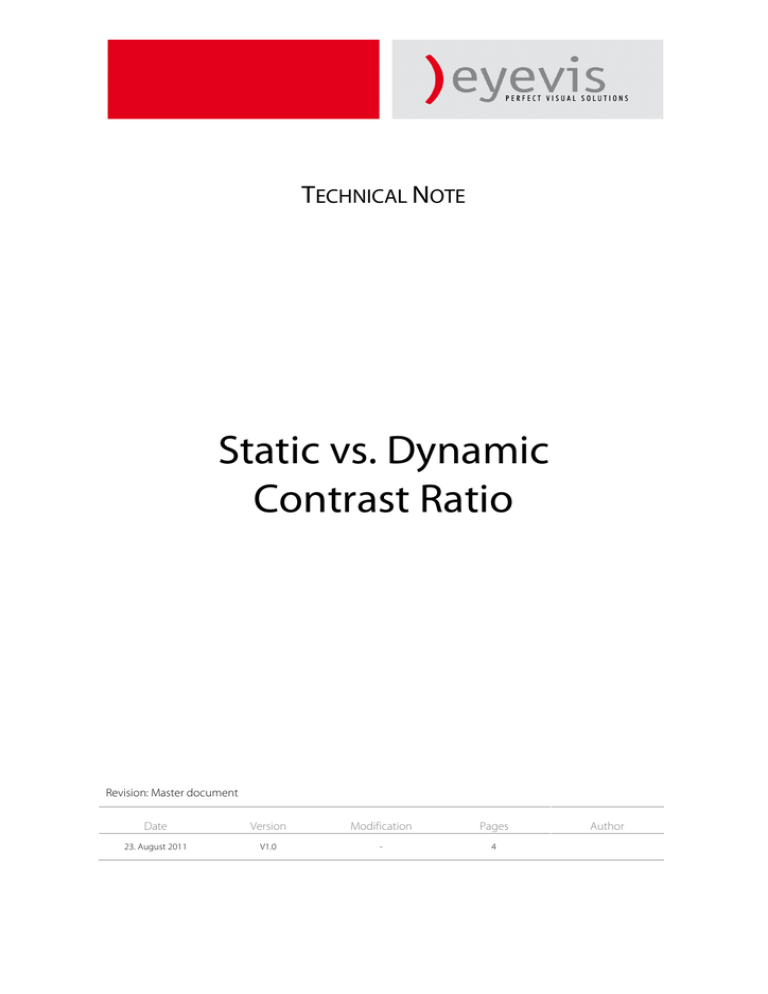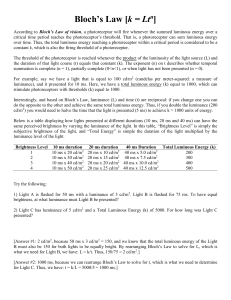
TECHNICAL NOTE
Static vs. Dynamic
Contrast Ratio
Revision: Master document
Date
Version
Modification
Pages
23. August 2011
V1.0
-
4
Author
Static vs. Dynamic Contrast Ratio
Technical note
23/08/2011
Static contrast ratio
The “static contrast” describes the contrast ratio of the luminance of the
brightest color (white) to that of the darkest color (black) at a fix display
setting, i.e. without any modification of the parameters during the
measurements but merely a switch of the video content from full white
to complete black.
Due to the characteristics of the technology, projection systems based
on a single DLP chip come with a “static contrast” of 1,000:1 to 2,000:1.
Dynamic contrast ratio
In contrast to the static contrast ratio there is the “dynamic contrast”.
Due to its measuring methods it results in much higher values than the
“static contrast” and is therefore preferred by manufacturer of consumer
LCDs.
The measurement of the dynamic contrast is based on modification and
individual settings for each colour, the brightest (white) and the darkest
(black). I.e. for white all display parameters are set to maximum whilst
they are reduced to minimum for black.
Significance for video walls
Transferred to LED-based systems, that means that you turn the LEDs to
full peak for white and dim them down as much as possible for black.
The result is a very high contrast ratio that fits perfectly in any brochure.
Manufactures of consumer LCD utilize this principle by applying some
electronics that measures and defines the average brightness of each
provides frame and adjust the brightness of the LED or backlight
accordingly. This feature works pretty well if you simply watch an action
movie from DVD (and if you don’t have a too close look) but can lead to
a “pumping” image because of the steadily changing brightness.
But it is a totally different story when it comes to video wall applications
where a picture is displayed over multiple screens.
page 2 of 4
Eyevis GmbH
Hundsschleestr. 23
72766 Reutlingen
Germany
www.eyevis.de
info@eyevis.de
Tel.: +49 7121 433 03- 0
Fax: +49 7121 433 03-22
Static vs. Dynamic Contrast Ratio
Technical note
23/08/2011
It isn’t hard to imagine what happens. Each image has brighter and
darker areas. If you split this picture into portions because you’re going
to feed each into a separate displays (video wall), each portion has a
different average brightness. Now, if each display adjusts the brightness
accordingly to its individual average brightness level without taking the
other LCDs/portions into consideration, the result is everything but
homogenous.
For TV/Broadcast studios it’s even worse because such adjustment
means don’t feature colour fidelity.
Infinity contrast
If you switch the LED / backlight off for the measurement if black, you
reach a contrast ratio of せ:1.
Brightness
The measure of luminous flux (luminous flux unit= ANSI LUMEN) doesn’t
exist for rear projection cubes but only for the integrated projectors. The
eyevis LED projectors used in the cubes come with 600-800 ANSI
Lumen.
The brightness of a rear projection cube is stated in luminance
(luminance unit cd/m²). This value depends on one hand of course on
the luminous intensity of the used projectors but on the other hand also
on the size and kind of the projection screen.
Given an equal luminous flux of the projector, the luminance of the
cube decreases the more the size of the projections screen increases.
Furthermore a BlackBead screen (BB) provides less luminance than a
CrossPrism screen (CP) of the same size, because the BB screen scatters
the light in a wider angle (=better viewing angle).
Therefore for rear projection cubes the luminous flux of the projector
doesn’t mean much and is hence of no real relevance. The achieved
luminance on the screen is of much more significance.
page 3 of 4
Eyevis GmbH
Hundsschleestr. 23
72766 Reutlingen
Germany
www.eyevis.de
info@eyevis.de
Tel.: +49 7121 433 03- 0
Fax: +49 7121 433 03-22
Static vs. Dynamic Contrast Ratio
Technical note
23/08/2011
Additional Support
For additional support for all eyevis products please contact:
eyevis GmbH
Hundsschleestr. 23
D-72766 Reutlingen
Germany
Phone: +49 (0) 7121 / 43303-290
Fax: +49 (0) 7121 / 43303-22
e-mail: info@eyevis.de
www: www.eyevis.de
As at: October 2009
Copyright © 2009 eyevis GmbH. All rights reserved.
This document, as well as the software described in it, is furnished under
copyright and may be used or copied only in accordance with the terms
of such right. Except as permitted by copyright, no part of this
publication may be reproduced, stored in a retrieval system, or
transmitted, in any form or by any means, electronic, mechanical,
recording, or otherwise, without prior written permission of eyevis
GmbH.
The content of this documentation is furnished for information use only,
is subject to change without notice, and should not be construed as a
commitment by eyevis GmbH. eyevis GmbH resumes no responsibility
or liability for any errors or inaccuracies that may appear in this
documentation.
eyevis, the eyevis Logo and eyecon are either registered trademarks or
trademarks of eyevis GmbH Deutschland.
All other trademarks are the property of their respective owners.
page 4 of 4
Eyevis GmbH
Hundsschleestr. 23
72766 Reutlingen
Germany
www.eyevis.de
info@eyevis.de
Tel.: +49 7121 433 03- 0
Fax: +49 7121 433 03-22



